Hello people; I hope you’re all doing fine. Today I’m going to share a fantastic guide on polycarbonate. It is one of the most utilized and popular thermoplastics worldwide, with numerous applications in Construction, Medical, Consumer Products, and Electronics. So without further ado, here we go.
What is Polycarbonate?
Polycarbonate (PC) is rigid, amorphous, and transparent thermoplastic material known for its high impact strength. It offers a lot of unique properties, keeping it always in demand among plastic manufacturers.
Although it is available in many commercial buying colors, the natural raw material is transparent in nature. Polycarbonate’s internal reflection and transmission capacity are as good as glass (which is rare in any thermoplastic material).
Polycarbonate molecular structure comprises repeating units of bisphenol A and phosgene, which bind together to create a straight chain. Functional groups such as hydroxyl and carbonyl are added to complete the structure.
With its fantastic properties like high impact strength, high dimensional stability, and decent electrical properties compared to other thermoplastic materials, the PC is often considered one of the best choices for engineering applications like automobiles, healthcare, construction, and electronics.
Polycarbonate Plastic is mainly used in manufacturing products where smash resistance and transparency are the main requirements – automotive components, protective gear, DVDs, Blu-rays, eyewear, greenhouses, medical devices, etc. There are many similarities between polycarbonate and polymethyl methacrylate’s, (Acrylic) properties.
However, PC stands out in factors like great compatibility with specific polymers, which increases its applications in many areas.
It is more robust and has better heat resistance (Melting point: 155°C ). However, it’s a bit expensive, which might be a problem for some manufacturers.
Polycarbonate is also known for its flexibility. The properties are similar to aluminum sheet metal, giving PC extra advantages.
That makes polycarbonate sheet stock beneficial when used for applications where sheet metal lacks feasibility.
Main Properties of Polycarbonate
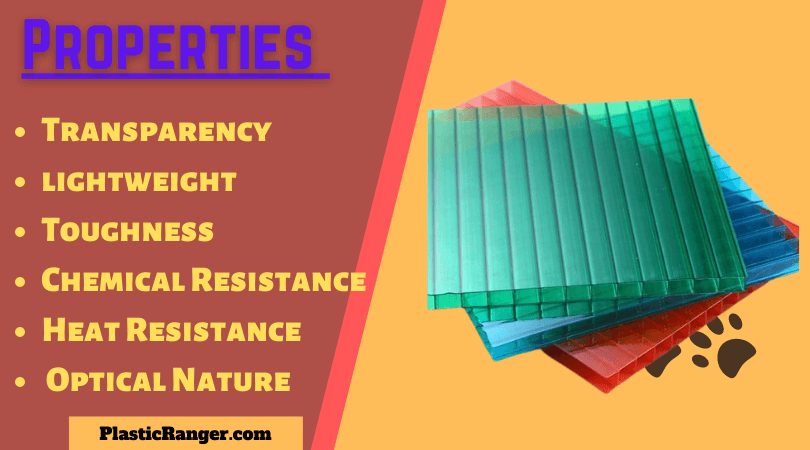
PC is categorized as thermoplastic, not a thermoset, because of its response to heat. One of the critical properties of thermoplastic is that it becomes liquid when heated.
Thermoplastics have an inherent advantage: once heated, cooled, and re-heated, most properties are retained without degradation.
Instead of burning, thermoplastic will liquefy, making it easier to process in injection molding and recycled later.
Let’s go through some of the properties
- Transparency
- lightweight
- Toughness and high-impact strength
- Chemical Resistance
- Heat Resistance
- Optical Nature
Transparency
PC is very clear plastic, and it transmits 90 of light which is as good as glass. Polycarbonate sheets are available in abundance in many shades.
PC sheets are easily customized depending on the applications without losing shape or bending.
Lightweight
Polycarbonate’s lightweight makes it highly sufficient for many applications. This opens many doors for manufacturers compared to glass.
The property makes PC more attractive than other thermoplastics because it improves efficiency, makes installation more accessible, and significantly reduces transportation costs.
Toughness and high impact strength
PC is virtually unbreakable. The thermoplastic’s high strength provides smash and fracture resistance, which is handy when producing safety gears, helmets, windows, doors, etc.
Polycarbonate density – 1.2 – 1.22 g/cm3), toughness – up to 140°C and down to -20°C.
Chemical Resistance
PC shows good chemical resistance to chemicals like aliphatic hydrocarbons, dilute acids, and alcohols. Modest resistance towards oils and greases. It’s affected by aromatic and halogenated hydrocarbons and diluted alkalis.
Manufacturers are often cautious when cleaning PC sheets because it is sensitive to abrasive alkaline cleaners. Using cleaning only a cleaning agent that doesn’t affect its chemical resistance is advisable.
Heat Resistance
Up to 135°, That’s the heat resistance provided by PC, which is quite decent. However, heat resistance can be improved by adding flame retardants without hurting the chemical properties.
Optical Nature
Even after having an amorphous structure, PC offers excellent optical characteristics with a refractive index of clear polycarbonate is 1.584.
Below is the table with the main properties and their respective values.
| Property | Value |
| Mechanical Properties | |
| Flexibility | 2.2-2.5GPa |
| Elongation at Break | 50-110% |
| Elongation at Yield | 6-7% |
| Young Modulus | 2.2-2.5GPa |
| Tensile Strength at Break | 55-77MPa |
| Tensile Strength at yield | 61-69MPa |
| Hardness Rockwell M | 70-90 |
| Hardness Shore D | 90-95 |
| Toughness at room temperature | 80-650J/m |
| Electrical Properties | |
| Dielectric Constant | 2.8-3 |
| Dielectric Strength | 16-35 kV/mm |
| Volume Resistivity | 15-16 x 1015 Ohm.cm |
| Dissipation Factor | 69-100 x 10-4 |
| Arc Resistance | 110-130sec |
| Dimensional Stability | |
| Shrinkage | 0.7-1% |
| Water Absorption 24 hours | 0.1-0.2% |
| Coefficient of Linear Thermal Expansion | 7-9 x 10-5 /°C |
| Physical Properties | |
| Glass Transition Temperature | 160-200°C |
| Density | 1.15-1.2g/cm3 |
| Optical Properties | |
| Transparency | 88-89% |
| Haze | 1% |
| Radiation Resistance | |
| UV Light Resistance | Satisfactory |
| Gamma Radiation Resistance | Good |
| Fire Performance | |
| Fire Resistance | 25-35 |
| Flammability UL94 | HB |
Types of Polycarbonate
According to Wikipedia, After many unsuccessful attempts to commercialize PC, it saw the light of day in the mid-1900s when it was simultaneously developed by both the United States and Germany.
Nowadays, some firms are selling commercially graded polycarbonate plastic with their unique signatures. The most popular variants include Lexan® by SABIC or Makrolon® by Bayer MaterialScience. There are many industrial grades available out there for polycarbonate. The primary differentiation between materials is done through the amount of glass fiber reinforcing and the melt flow variance.
Including additives depending on the applications is also quite common when buying commercial polycarbonates. Ultraviolet stabilizers are a good example, often blended for long-term protection from the sun; another good example is mold release agents used for smooth materials removal while processing.
How is PC Manufactured?
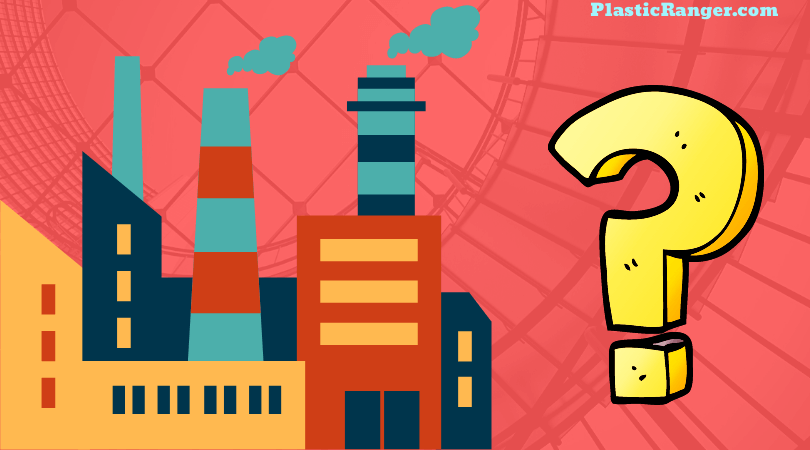
The most common manufacturing process for PC is the condensation polymerization of bisphenol A (BPA; C15H16O2) and phosgene (COCl2).
Here are the common methods
- Injection Molding
- Extrusion Molding
- Blow Molding
- Thermoforming
PC is supposed to be melted and forced into the mold with high pressure to mold it into the desired shape. Dying before processing – 2-4 hr at 120°C is crucial for smooth material flow.
Target moisture must be at a maximum of 0.02%.
Injection Molding
Injection molding is the most sought-after process of polycarbonate material. One of the polycarbonate’s signature properties is being very sticky, so it is processed at a very high temperature to reduce the stickiness.
Here, hot molten material is forced through a mold with high pressure. Once the mold cools, it shapes the material in the desired way.
Polycarbonate is widely used in injection molding to manufacture products like PC bottles, Plates, containers, etc.
It should be kept in mind that polycarbonate is a poor-doing material, so the wall thickness should not be skinny.
Extrusion Molding
In this method, the molten material ( Recommended Temperature – 230-260°C) passed through a cavity, giving it the final shape. When the material cools, it acquires the desired shape.
The process is highly utilized to manufacture PC sheets, pipes, profiles, etc.
Makrolon Plastics
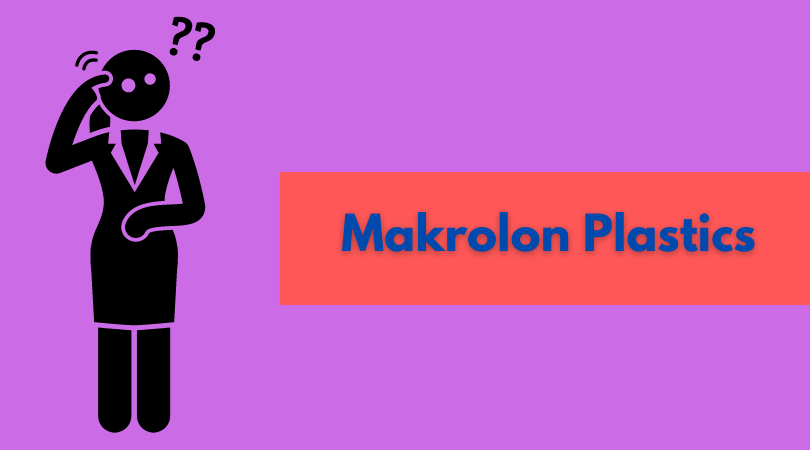
Makrolon® or Tuffak is one of the most popular trade names for polycarbonate. That’s why I thought it’s worth mentioning, as you will see this PC version mostly in all the manufacturing units.
Makrolon is known for its unparalleled robustness, transparency, lightweight, and excellent impact resistance, even at low temperatures.
High dimensional stability, easy moldability, and impressive heat resistance are also some handy properties.
The number of applications for this version of polycarbonate is high. It is extensively used in manufacturing medical devices, sporting equipment, eyewear, electronics, LED lighting, etc.
Lexan and Plexiglass are alternatives to Makrolon with the same strength and properties.
Advantages and Disadvantages

| Advantages | Disadvantages |
| Highly Transparent. Offers transparency as good as glass | After exposure for an elongated time at 60°C, their mechanical properties start to degrade and perish. |
| Toughness stays stable even down to -20°C | Easily affected by chemicals like hydrocarbons and bases. |
| Impressive mechanical retention at up to 140°C | Proper dyeing is a must before processing. |
| Can resist continuous shots of steam sterilization | Low fatigue tolerance |
| Excellent abrasion resistance | Turns yellow after prolonged exposure to UV |
Flame retardant | NA |
Polycarbonate Applications
- Automotive
- Consumer Products
- Construction
- Electronics
- Medical
Automotive

PC is used in the automobile industry to create sophisticated design components, lightweight, strong, and durable. Its durability and lightweight also help automobiles to maintain their aerodynamics.
Because of its good heat-resistant properties, PC is often considered in lenses, headlamp bezels, and lenses.
Consumer Products

Polycarbonate has low internal stress and high dimensional stability, making it compatible with manufacturing DVDs.
High Transparency also makes PC suitable for producing glasses, ophthalmic lenses, big and small water bottles, etc.
It is also optical enough to be used in face shields, protective glasses, plastic glasses for optic purposes, and shatterproof sunglasses, and it even plays a part in bulletproof glasses.
Construction

In the construction industry, PC is extensively used as an alternative to glass in numerous glossing applications like facades, security windows, public or private property, shelters, public lights, agricultural houses, etc.
Good weatherability, high strength, and resistance help PC provide excellent quality products that are good enough to tackle the glass.
Electronics
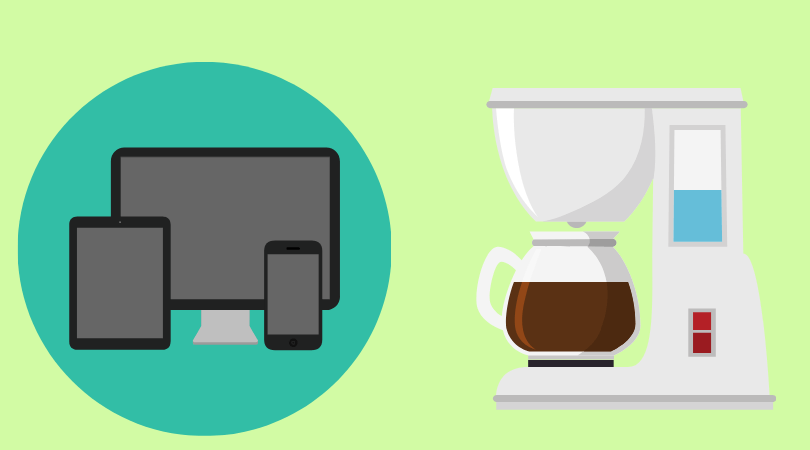
PC and its different blends are heavily used in electronic appliances like TVs, refrigerators, coffee machines, washing machines, beard trimmers, hairdryers, etc.
The use of PC helps shape the products in numerous geometries, and the high strength and excellent mechanical properties help create robust and tough products.
Medical

Polycarbonate is used in medical appliances keeping in mind its heat resistance, dimensional stability, clarity, and toughness.
PC is sterilized by ethylene oxide and limited autoclave cycles.
The main applications are syringes, surgical instruments, thermometers, blood-storing products, blood filters, drug delivery, drug stores, and delivery systems,
Back in the day, these products were made up of glass, but now PC have replaced glass completely.
Major Manufacturers
These are the top manufacturers of PC material and its variants used for various applications.
- Covestro AG
- TEIJIN Limited
- LOTTE Chemical Corporation
- Mitsubishi Engineering Plastic Corporation
- SABIC(Saudi Basic Industries Corporation)
Polycarbonate Safety and its Recyclability
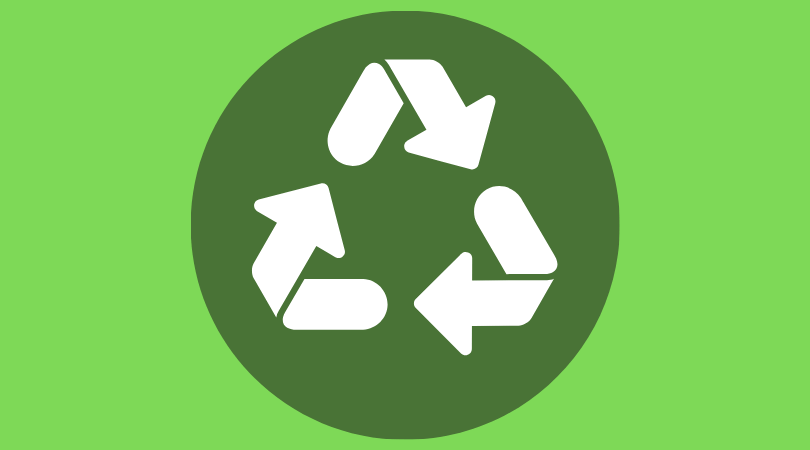
Polycarbonate plastic is heavily used in consumer products in constant human contact. The prime examples include sippy cups, baby feeding bottles, water bottles, and containers.
The safety and health factor around PC is so mainstream because it is made with bisphenol A (BPA).
Many publications from R&D institutes worldwide are working consistently to decrease the BPA used in polycarbonate, especially in the foods and beverages sectors.
These researches have shown time and time again that there’s no potential risk to human life if you come in contact with PC products.
Numerous regulatory authorities worldwide, such as US FDA, the European Commission’s Scientific Committee on Food, and the UK Food Standards Agency, have acknowledged the safety of PC products.
However, some studies show the dangerous effects of BPA on the human body leading to “BPA-free” polycarbonate products.
Regarding recyclability, polycarbonate plastic is 100% recyclable and identified by recycling code “7”.
There are several processes for recycling, but the most common method is chemical recycling, where used; scrapped PC is blended and recreated with phenol to produce monomers.
History of Polycarbonate
The first variant of polycarbonate was made from a mistake when researcher E. I. Carothers of the DuPont company started studying polyester resins.
He was trying to find a stable material to fix the fluctuating price of spun cotton and integrate the availability of cotton in the market.
The new creation was challenging and transparent but too average for the time. It was kept on the shelf for years till the year 1952, when several scientists became interested in polycarbonate polymer and successfully recreated it in their laboratories.
However, it still took a few more years to make an actual product from polycarbonate ready to be sold in the market.
The industrial production of polycarbonate started in 1959, and the initial years were tough as people were still not accepting of something so exceptionally sturdy, non-toxic, and transparent.
Still, the general American approach towards polycarbonate hung at the beginning of the 1970s with more awareness of plastic products and successful marketing campaigns.
Soon it started gaining traction in the medical, food & catering industries thanks to its easy sterilization and disposibility.
The Future of Polycarbonate
According to studies conducted pre-COVID-19 PC market is growing at a CAGR of 4%, which is decent. Any information about growth in the entire thermoplastics market should be taken with a pinch of salt in the short term.
The biggest consumer of polycarbonate is the automobile industry struggling with low sales even before the pandemic changed our lives and forced us to stay indoors.
So, soon manufacturing companies utilizing PC will look at the electronics and electrical industries for future growth (at least in the short term).
In the North American region, specifically in the USA, the electronics industry is said to grow at a moderate pace in for coming years, so that part also possesses some opportunities.
Other than electronics and electrical, the construction industry can also keep PC on the growth track in the Asian region as it is said to recover from the pandemic sooner than the world (China and India’s economies are recovering from pandemics sooner than the world)
FAQs
In what terms is polycarbonate better than other plastic materials?
Polycarbonate is the most reliable plastic material in terms of impact strength and weather resistance. Polycarbonate sheets have been proven to be more supreme than all other plastics in applications where impact strength has a significant role to play. I don’t want to sound cocky, but it is said that it is impossible to break it unless you use some heavy equipment.
Which is better, polycarbonate or PVC
Polycarbonate is way stronger than PVC, but that excellent impact strength we all talk about so much makes it more expensive than the competitor. However, PVC has better search resistance, whereas polycarbonate is more prone to scratches easily.
Is polycarbonate unbreakable?
Polycarbonate is considered virtually unbreakable and is thus used in bulletproof glasses. It is considered 200 times stronger than glass and 30 times stronger than acrylic.
For how long do polycarbonate panels last?
In terms of longevity, polycarbonate has an impressive track record. Any polycarbonate application, including roofing ( Which tends to face more drastic environmental conditions), lasts for about 10 – 20 years. However, specific warranty varies from manufacturer to manufacturer; some also provide lifetime warranty for polycarbonate products.
Which is cheaper? Glass or Polycarbonate?
Polycarbonate is way cheaper than glass (although the price difference might vary depending on the country), has better applicability, and is also easier to work with.
What is the best thickness of polycarbonate for a greenhouse?
According to several customer reviews, when choosing polycarbonate sheets for your greenhouse, we recommend a minimum gauge of 3mm for suitable rigidity because customer reviews have stated that sheets with 2mm thickness can bend easily, a problem seen more in larger panels.
Suggested Read
- How is Plastic made? A Simple and Detailed Explanation.
- What is PTFE (Polytetrafluoroethylene)? | The Complete Guide
- What is Polystyrene? | The Definitive Guide
- What is UHMW Plastic Material? | The Definitive Guide
- Food Grade Plastic: The Best Plastics for Food Applications
- What is LDPE? | Low-Density Polyethylene | The Complete Guide
- 7 Types of Plastics | An Helpful Illustrated Guide
- What is PETG Material? | The Definitive Guide
Final Thoughts
To sum up, polycarbonate plastic is a widely utilized material with various advantages, including high impact resistance, exceptional optical clarity, and longevity. However, it also entails specific health and environmental hazards, as bisphenol A (BPA) could potentially be released during its production and use.
Therefore, appropriate care must be taken when handling and disposing of this material. Moreover, alternative materials with comparable features and fewer health and environmental implications are being researched, such as biodegradable and plant-based plastics.
Both manufacturers and consumers must evaluate the benefits and drawbacks of polycarbonate plastic and explore sustainable options to reduce any negative impacts.
Thanks for reading. I would appreciate it if you shared your feedback in the comment box.
Quick Navigation

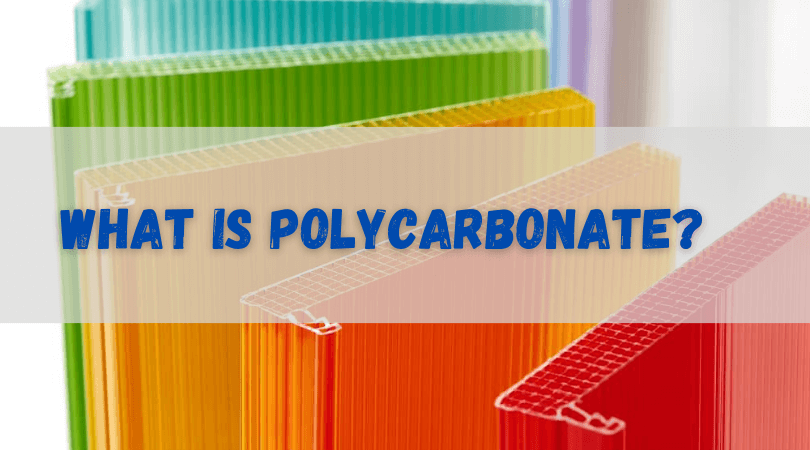
Excellent exposition on polycarbonate
Thank you very much.
Nice article overall, But I’m having a hard time accepting that polycarbonate is used in making bulletproof products.
Polycarbonate is also used in bulletproof glasses, car windows, and vests.
Hey there, I saw your blog and it was amazing.
As an alternative to glass, polycarbonate sheet has many advantages that glass doesn’t have. You can bend polycarbonate flat sheets or polycarbonate twin wall sheets (polycarbonate sheet bend radius). Because polycarbonate panels are bent, they can be used in almost any design which normal glass can’t do.
what you wrote was very helpful.
Thank you very much
A nic detailed article on polycarbonate. Glad I stumbled upon your website.
Lovely Article. Thank You
Lovely piece of information.
Is it possible that polycarbonate can be used fr making pipes?